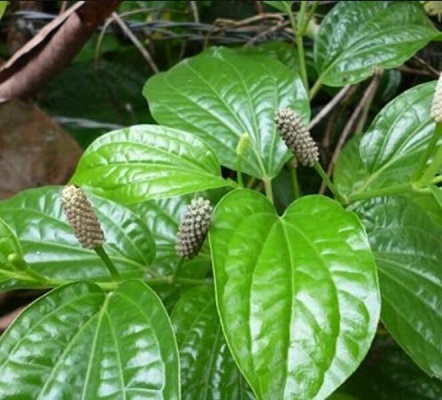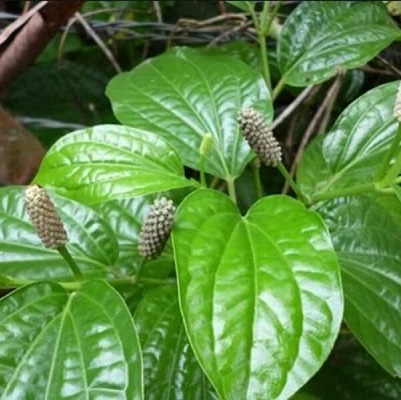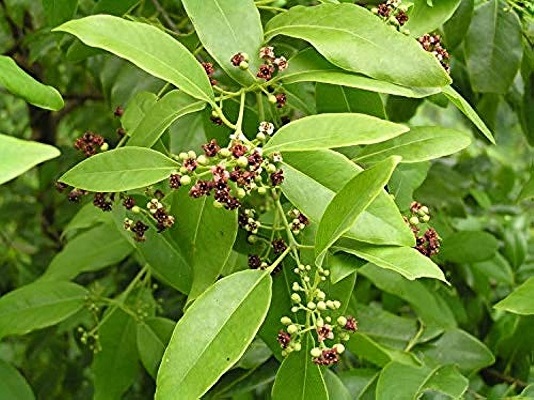On This Page
Cavya (Piper chaba) – Uses and Benefits
Introduction
Cavya, commonly known as Java long pepper is one of the most widely used and readily available herb in Ayurveda. The name Cavya means that the plant is having very good taste so it is commonly chewed by many. The plant have significant resemblance to pepper and have properties as that of Pepper. Hence it is also known as Gaja pippali. The plant mainly grows in Western ghats.
Dr. Gupta’s Institute of Applied Food Allergy, shortly known as IAFA, has been consistently working on Cavya to find out more medicinal properties of the plant. Our experts have successfully proven the activities like Expectorant, Appetizer, Digestive, anti-inflammatory, antimicrobial, digestant, and insecticidal properties of Cavya. The plant can be used to treat diseases like Diarrhea, Ascites, Skin disorders, Worm infestations, Cough, Itching, Fever etc. The ethanolic extracts of the plant have excellent anti-inflammatory properties. It helps to alleviate oedematous conditions. The extracts have also found to have analgesic activities. Our experts have also proven the Antipyretic activity of the plant.
Action of Cavya – Piper chabain Allergies
Our IAFA experts have successfully proven the antiallergic, antimicrobial and anti-inflammatory properties of the plant Cavya. The plant contains phytoconstituents like piperine, piperonucline, piperidine, chavicine and these helps in its antiallergic action. Decoction prepared from Cavya can be used to treat skin allergic conditions and worm infestations.
Vernacular Names
| Sanskrit Name | Cavya, Hasthipippali, Chavika |
| Hindi Name | Chaba |
| English Name | Javalong pepper |
| Malayalam Name | Chavyam |
| Kannada Name | Gaja pippali |
| Marathi Name | Chabhaka |
Botanical Name
Piper chaba
Family
Piperaceae
Morphology of Cavya – Piper chaba
- Branched woody climber
- Leaves are elliptic ovate
- Leaves acuminate
- Fruits are small ovoid or globose
Ayurveda Reference of Cavya – Piper chaba
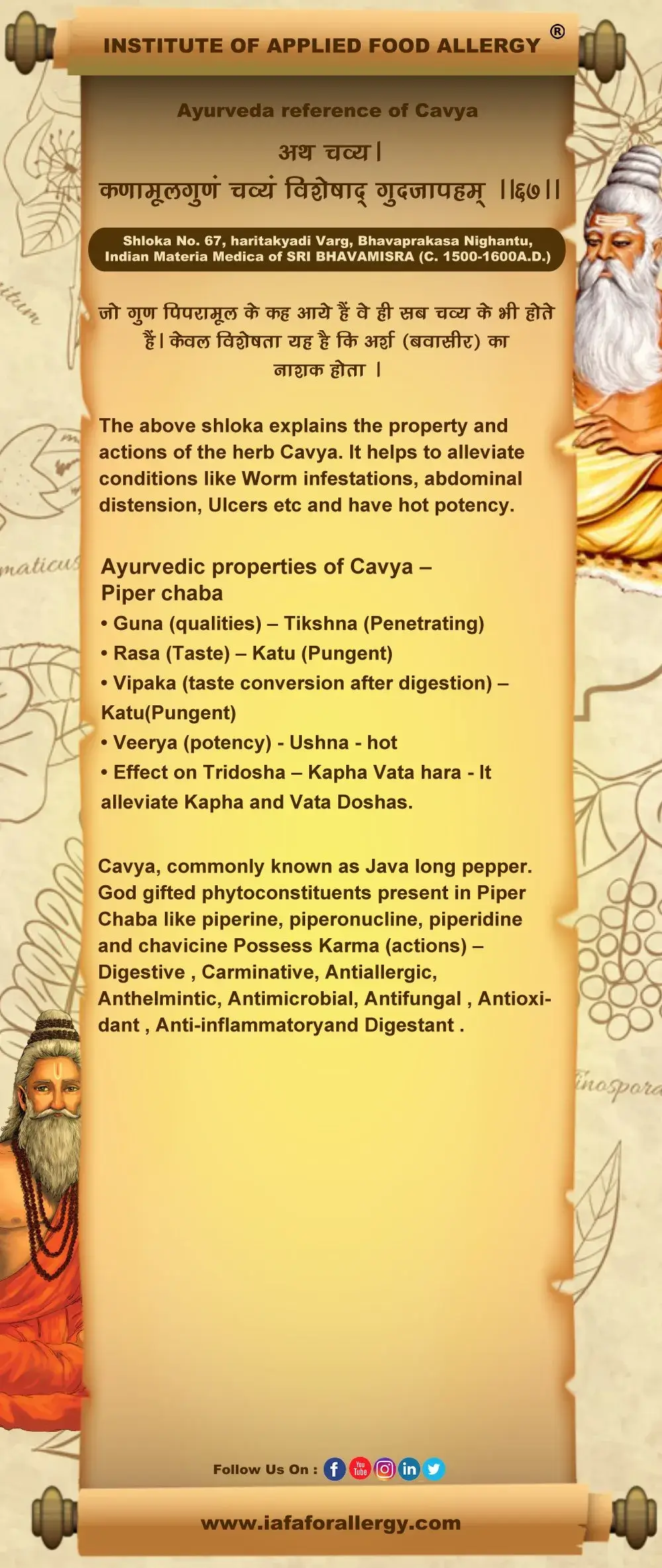
Geographical Distribution of Cavya – Piper chaba
Cavya seen in South Indian states like Karnataka, Kerala, Tamilnadu & Andhra Pradesh also in West Bengal, Uttar Pradesh.
Phytoconstituents of Cavya – Piper chaba
Root is having piperine, piperonucline, piperidine, chavicine.
Parts Used of Cavya – Piper chaba
- Fruit
- Root
Dosage of Cavya – Piper chaba
- Powder (churna) – 2 g
Medicinal Properties of Cavya – Piper chaba
- Kushtaghna – alleviate skin disorders
- Krimighna – useful in worm infestations
- Kandughan – relieves itching
- Vishaghna – useful in poisoning
- Kasa hara – relieves cough
- Sulahara – relieves pain
- Sophahara – relieves swelling
- Swasahara – relieves asthma.

Have A Health Issue?
Consult Online
- Dr. Sahil Gupta (B.A.M.S., M.H.A.)
Ayurvedic Allergy Specialist
CEO & Founder of IAFA®
Home Remedies of Cavya – Piper chaba
Ayurveda is an ancient treatment system which is purely based on naturally available herbs and materials for the purpose of alleviating diseases. The herbs used in Ayurvedic treatments are toxic free and have no side effects at all. Cavya is one of the most commonly available herbs and can be used to treat diseases like:-
- In Diarrhoea (Atisara) – Cavya fruit is sweetened with honey and sugar and is taken internally to alleviate Atisara.
- In Ascites (Udara) – One should take paste prepared from Cavya and Ginger internally.
- In Fever (Jwara) – 5-7 fruits of Gajapippali are collected and made into decoction by adding 4 times water. It is then taken orally.
- In Colic pain (Sula) –Gajapippali along with Zingiber officinale is made into decoction. Drinking this decoction at a dose of 60 ml can cure colic pain
- In vomiting (Chardi) – Cavya is consumed along with ghee, honey and sugar. It can immediately alleviate vomiting
- In Cough (Kasa) – 6-7 fruits of Cavya is taken and powdered well. It is then taken along with Solanum xanthocarpum and honey.
- In Worm infestation (Krimi roga) – Decoction prepared by crushing root of Cavya is taken along with Goat’s urine.
- In Diabetes (Prameha) – Decoction made with Cavya and Phyllanthus emblica is taken internally at a dose of 60 ml.
IAFA, guided by Dr. Gupta mainly aims in promotion of Ayurvedic science. We use naturally available herbs to cure diseases especially allergic conditions. IAFA follows guidelines that are purely based on Ayurveda textbooks for treatment purposes. By consistently hard working, we are able to provide you risk free medicines.
Reach IAFA for safe herbal remedies for all your ailments!!!
Was this Page Helpful?
Read More Articles
-
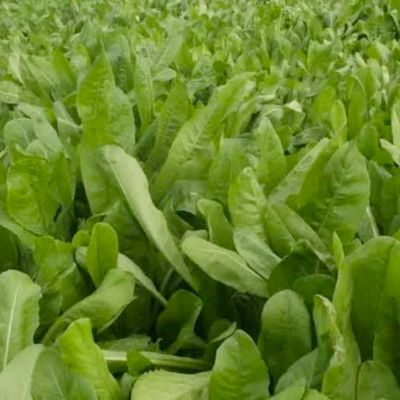
Kasini (Cichorium intybus)
Kasini (Cichorium intybus) commonly known as Chicory is a perennial herb, with large…
-
-

